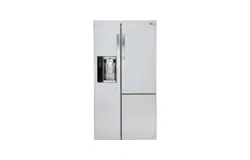Documents: Go to download!
User Manual
- User Manual - (English, French, Spanish)
- Specification - (English)
- PRODUCT FEATURES
- COMPONENTS
- INSTALLATION
- HOW TO USE
- MAINTENANCE
- SMART DIAGNOSIS
- TROUBLESHOOTING
Table of contents
User Manual
PRODUCT FEATURES
DOOR-IN-DOOR REFRESHMENT CENTER
The Door-in-Door Refreshment Center provides a convenient area for frequently-used items that require easy access.

FRESH ZONE DRAWERS
The Fresh Zone drawers are designed to help keep your fruits and vegetables fresh.

DOOR ALARM
The Door Alarm function is designed to prevent refrigerator malfunctioning that could occur if a refrigerator door remains open. If a refrigerator door is left open for more than 60 seconds, a warning alarm SOUNDSAT 30-second intervals.

AUTO CLOSING HINGE
The refrigerator doors close automatically with a slight push. (The door only closes automatically when it is open at an angle less than 30°.)
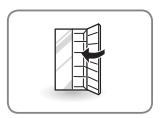
ICE PLUS
Ice production can be increased by approximately 20 percent when the freezer section is maintained at the coldest temperature for 24 hours.
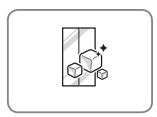
COMPONENTS
Refrigerator Exterior for Door-In-Door Models

Refrigerator Exterior for Standard Model
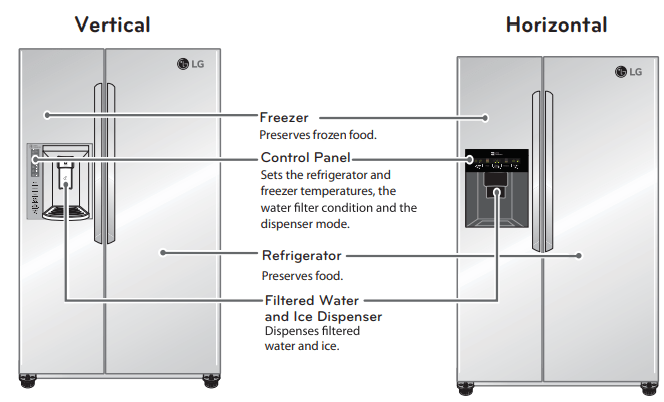
Refrigerator Interior for Door-In-Door Models
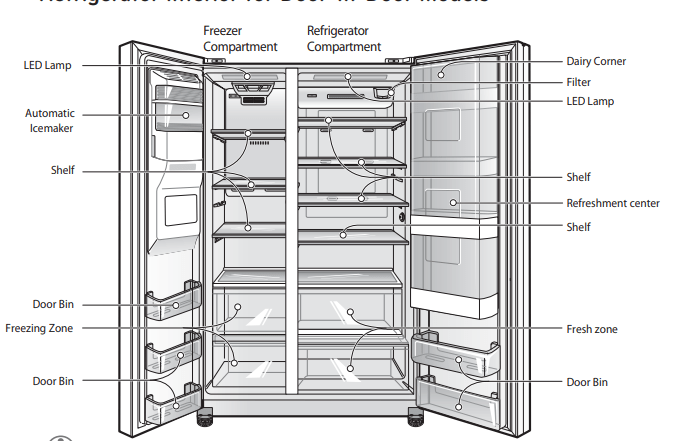
Refrigerator Interior for Standard Model
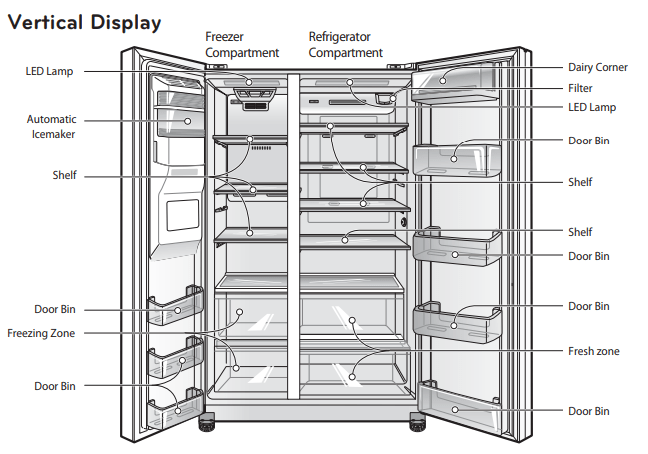
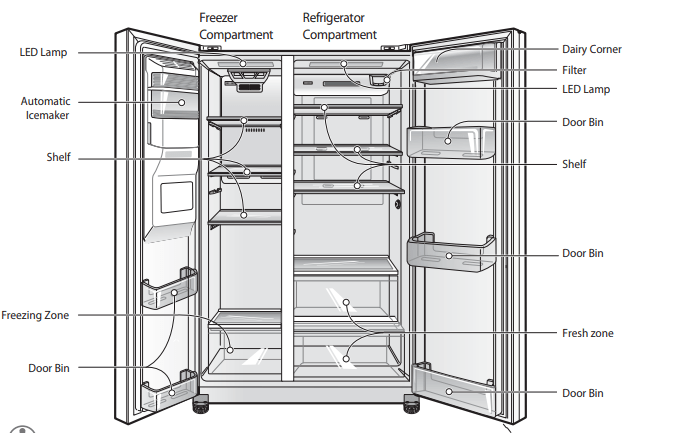
INSTALLATION
Installation Overview
Please read the following installation instructions first after purchasing this product or transporting it to another location

Specifications
The appearance and specifications listed in this manual may vary due to constant product improvements
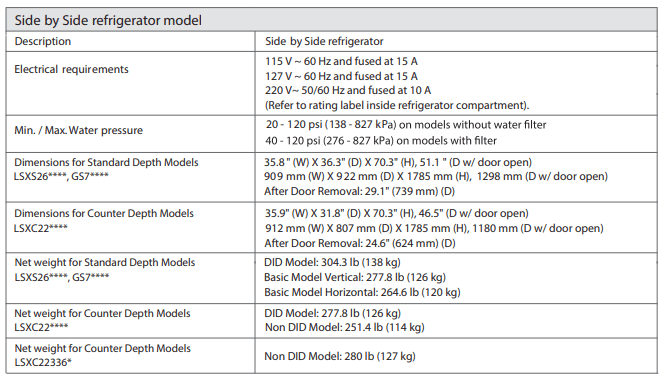
Unpacking Your Refrigerator
Remove tape and any temporary labels from
Please remove vinyl for the om doors before connecting unit to the electrical supply (on some models). your refrigerator before using. Do not remove any warning-type labels, the model and serial number label
To remove any remaining tape or glue, rub the area briskly with your thumb. Tape or glue residue can also be easily removed by rubbing a small amount of liquid dish soap over the adhesive with your fingers. Wipe with warm water and dry.
Please remove vinyl from doors before connecting unit to the electrical supply (on some models).
Do not use sharp instruments, rubbing alcohol, flammable fluids, or abrasive cleaners to remove tape or glue. These products can damage the surface of your refrigerator.
Refrigerator shelves are installed in the shipping position. Please reinstall shelves according to your individual storage needs.
Choosing the Proper Location
- Select a place where a water supply can be easily connected for the automatic icemaker.
- The refrigerator should always be plugged into its own individual properly grounded electrical outlet. This provides the best performance and also prevents overloading house wiring circuits which could cause a fire hazard from overheated wires. It is recommended that a separate circuit serving only this appliance be provided.
Flooring
To avoid noise and vibration, the unit must be leveled and installed on a solidly constructed floor. If required, adjust the leveling legs to compensate for unevenness of the floor. The front should be slightly higher than the rear to aid in door closing. Leveling legs can be turned easily by tipping the cabinet slightly. Turn the leveling legs to the left to raise the unit or to the right to lower it. (See Leveling and Door Alignment.)
Ambient Temperature
Install this appliance in an area where the temperature is between 55°F (13°C) and 110°F (43°C). If the temperature around the appliance is too low or high, cooling ability may be adversely affected.
Measuring the Clearances
Too small of a distance from adjacent items may result in lowered freezing capability and increased electricity consumption charges. Allow at least 24 inches (61 cm) in front of the refrigerator to open the doors, and at least 2 inches (5.08 cm) between the back of the refrigerator and the wall as well as on the sides of the refrigerator and adjacent walls or objects

Replacement of lamp
The refrigerator compartment lamps a LED interior lighting, so maintenance must be performed by a qualified technician.
Removing/Assembling the Refrigerator Door Handles
Removing the Handles
- Loosen the set screws with a 3/32 in. Allen wrench and remove the handle.
- Loosen the mounting fasteners that connect to the refrigerator door and handle using a ¼ in. Allen wrench, remove the mounting fasteners.
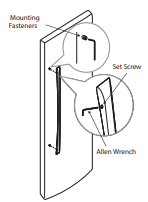
Assembling the Handles
- Assemble the mounting fasteners at both ends of the handle using a ¼ in. Allen wrench.
- Place the handle on the door by fitting the handle footprints over the mounting fasteners and tightening the set screws with a 3/32 in. Allen wrench.
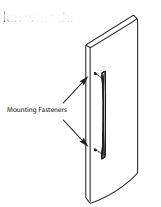
Removing/Assembling the Refrigerator Doors
When it is necessary to move the refrigerator through a narrow opening, removing the doors is the recommended procedure.
Removing the Left (Freezer) Door Witthe h Water Line Connection
1. Loosen the hinge cover screws and remove the hinge cover. Disconnect all wire harnesses.
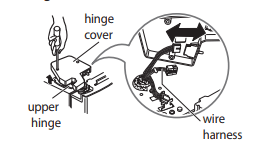
2. Rotate the hinge lever counterclockwise ( 1) and lift the upper hinge ( 2).
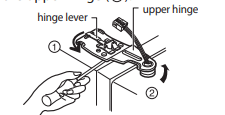
3. Remove the freezer compartment door by lifting it upward. This time, the door should be lifted enough for the water feed tube to be completely pulled out.
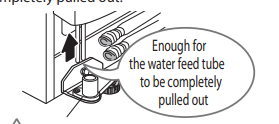
Removing the Right (Refrigerator) Door
- Open the door. Remove the top hinge cover screw. the white or blue tube is still connected. To remove connectors use the support block that is on the upper shelf in the refrigerator.
- Use a flat-blade screwdriver to pry back the hooks (not shown) of the hinge cover from the top of the refrigerator cabinet. Lift up the cover. Disconnect all wire harnesses.


3. Rotate the hinge lever clockwise (1). Lift the upper hinge free of the hinge lever latch (2).
4. Lift the door from the lower hinge pin
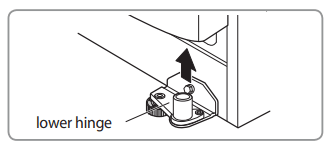
5. Place the door, inside facing up, on a non-scratching surface.
Reinstalling the Right (Refrigerator) Door
- Place the door onto the lower hinge pin.
- Fit the upper hinge over the hinge lever latch and into place. Rotate the lever counterclockwise to secure the hinge
- Reconnect all wire harnesses. Hook the tab on the switch side of the cover under the edge of the wire opening in the cabinet top. Position the cover and replace the screw.
Reinstalling the Left (Freezer) Door
1. Feed the water tubes through the lower hinge pin and place the door onto the lower hinge pin. Water hoses should be behind the leg to prevent damage
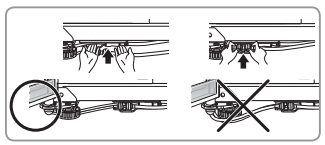
2. Fit the top hinge over hinge lever latch and into place. Rotate the lever clockwise to secure the hinge.
3. Install the grounding screw and connect all the wire harnesses.
4. Hook the tab on the door switch side of the cover, under the edge of the wire, opening in the cabinet top. Position the cover into place. Insert and tighten the cover screw.
5. Reconnect the water tubes by inserting the tubes into the connectors. The tube is inserted correctly when only one guideline is showing out of two

Open the door and turn the hose toward the inside. Water hoses should be behind the leg to prevent dame tube .

The tube is completely inserted when only one guideline is showing out of two.

Water hoses should be cut with a clean, straight edge to avoid leaks.

Connecting the Water Line
Before You Begin
This water line installation is not covered by the refrigerator warranty. Follow these instructions carefully to minimize the risk of expensive water damage.
Water hammer (water banging in the pipes) in house plumbing can cause damage to refrigerator parts and can lead to water leakage or flooding. Call a qualified plumber to correct water hammer before installing the water supply line to the refrigerator.
Water Pressure
You will need a cold water supply. The water pressure must be between 20 and 120 psi ( 138 – 827 kPa ) on models without a water filter and between 40 and 120 psi ( 276 – 827 kPa ) on models with a water filter. If the water pressure does not reach the minimum required pressure, a separate booster pump may be required for normal automatic icemaker and cool water dispensing operation.
If a reverse osmosis water filtration system is connected to your cold water supply, this water line installation is not covered by the refrigerator warranty. Follow these instructions carefully to minimize the risk of expensive water damage.
If a reverse osmosis water filtration system is connected to your cold water supply, the water pressure to the reverse osmosis system needs to be a minimum of 40 to 60 psi (276 - 413 kPa, or less than 2.0~3.0 sec. to fill a cup of 7 oz capacity).
If the water pressure from the reverse osmosis system is less than 21 psi or 1.5 kg/cm2 (takes more than 4.0 sec to fill a cup of 7 oz capacity):
- Check to see if the sediment filter in the reverse osmosis system is blocked. Replace the filter if necessary.
- Allow the storage tank on the reverse osmosis system to refill after heavy usage.
- If the issue concerning water pressure from reverse osmosis remains, call a licensed, qualified plumber.
- All installations must be by local plumbing code requirements.
What You Will Need
- Copper Tubing, ¼ in. outer diameter, to connect the refrigerator to the water supply. Be sure both ends of the tubing are cut square.
To determine how much tubing you need: measure the distance from the water valve on the back of the refrigerator to the water supply pipe. Then, add 8 feet (2.4 m). Be sure there is sufficient extra tubing (about 8 feet [2.4 m] coiled into 3 turns of about 10 in. [25 cm] diameter) to allow the refrigerator to move out from the wall after installation. Keep the total length of the feed water pipe tube within 26 ft (8 m). Be careful to avoid getting a kink in the tube. If the tube is longer than 26 ft (8 m), it may cause the water feed to malfunction.

- Power drill.
- ½ in. or adjustable wrench.
- Flat blade and Phillips head screwdrivers.
- Two ¼ in. outer diameter compression nuts and 2 ferrules (sleeves) to connect the copper tubing to the shutoff valve and the refrigerator water valve.
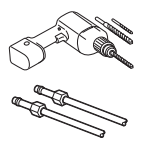
- If your existing copper water line has a flared fitting at the end, you will need an adapter (available at plumbing supply stores) to connect the water line to the refrigerator OR you can cut off the flared fitting with a tube cutter and then use a compression fitting.

- Shut off valve to connect to the cold water line. The shutoff valve should have a water inlet with a minimum inside diameter of 5/32 in. at the point of connection to the COLD WATER LINE. Saddle-type shutoff valves are included in many water supply kits.Before purchasing, make sure a saddle-type valve complies with your local plumbing codes.

Water Line Installation Instructions
Install the shutoff valve on the nearest frequently used drinking water line.
1. SHUT OFF THE MAIN WATER SUPPLY
Turn on the nearest faucet to relieve the pressure on the line.
2. CHOOSE THE VALVE LOCATION
Choose a location for the valve that is easily accessible. It is best to connect into the side of a vertical water pipe. When it is necessary to connect to a horizontal water pipe, make the connection to the top or side, rather than at the bottom, to avoid drawing off any sediment from the water pipe.
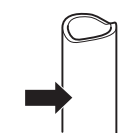
3. DRILL THE HOLE FOR THE VALVE
Drill a ¼ in. hole in the water pipe using a sharp bit. Remove any burrs resulting from drilling the hole in the pipe. Be careful not to allow water to drain into the drill. Failure to drill a ¼ in. hole may result in reduced ice production or smaller cubes.
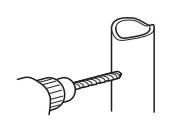
4. FASTEN THE SHUTOFF VALVE
Fasten the shutoff valve to the cold water pipe with the pipe clamp.
5. TIGHTEN THE PIPE CLAMP
Tighten the clamp screws until the sealing washer begins to swell.

6. ROUTE THE TUBING
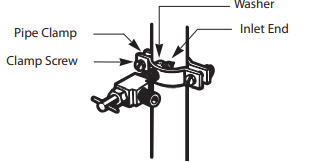
Route the tubing between the cold water line and the refrigerator.
Route the tubing through a hole drilled in the wall or floor (behind the refrigerator or adjacent base cabinet) as close to the wall as possible.
7. CONNECT THE TUBING TO THE VALVE
Place the compression nut and ferrule (sleeve) for copper tubing onto the end of the tubing and connect it to the shutoff valve. Make sure the tubing is fully inserted into the valve. Tighten the compression nut securely
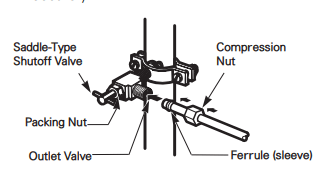
8. FLUSH OUT THE TUBING
Turn the main water supply on and flush out the tubing until the water is clear.
Shut the water off at the water valve after about one quart of water has been flushed through the tubing.
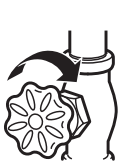
9. CONNECT THE TUBING TO THE REFRIGERATOR
NOTE: Before making the connection to the refrigerator, be sure that the refrigerator power cord is not plugged into the wall outlet.
a. Remove the plastic flexible cap from the water valve.
b. Place the compression nut and ferrule (sleeve) onto the end of the tubing as shown.
c. Insert the end of the copper tubing into the connection as far as possible. While holding the tubing, tighten the fitting.
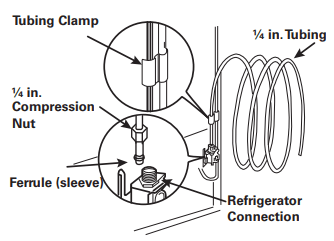
10. TURN THE WATER ON AT THE SHUTOFF VALVE
Tighten any connections that leak

11. PLUG IN THE REFRIGERATOR
Arrange the coil of tubing so that it does not vibrate against the back of the refrigerator or the wall. Push the refrigerator back to the wall.
12. START THE ICEMAKER
The ice maker will not begin to operate until it reaches its operating temperature of 15°F (–9°C) or below.
Turning On The Power
1. Plug in the refrigerator
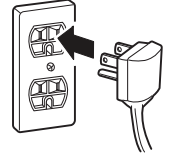
Leveling
After installing, plug the refrigerator’s power cord into a 3-prong grounded outlet and push the refrigerator into the final position
Your refrigerator has two front leveling legs— one on the right and one on the left. Adjust the legs to alter the tilt from front to back or side-to side. If your refrigerator seems unsteady, or you want the doors to close more easily, adjust the refrigerator’s tilt using the instructions below:
1. Turn the leveling leg counterclockwise to raise that side of the refrigerator or clockwise to lower it. It may take several turns of the leveling leg to adjust the tilt of the refrigerator.
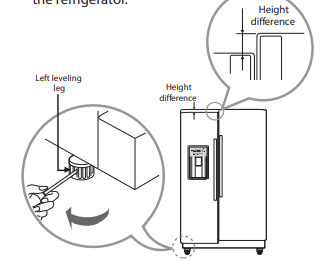
NOTE: Having someone push backward back the top of the refrigerator takes some weight off of the leveling legs. This makes it easier to adjust the legs.

2. Open both doors again and check to make sure that they close easily. If the doors do not close easily, tilt the refrigerator slightly more to the rear by turning both leveling legs counterclockwise. It may take several more turns, and you should turn both leveling legs the same amount.
Door Alignment
If the doors are still uneven after the refrigerator has been leveled, finish adjusting the doors by following the instructions below:
Adjusting tools: 5/16” (8mm) wrench and 3/4” (19mm) wrench.
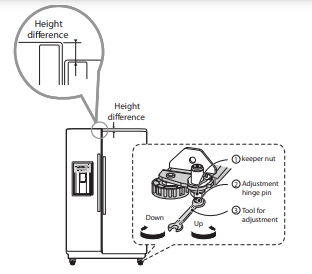
- Using a 3/4” (19mm) wrench, turn the keeper nut counterclockwise to loosen the keeper nut.
- Using a 5/16” (8mm) wrench, turn the adjustment hinge pin clockwise or counterclockwise to level the refrigerator door.
- After leveling the door, turn the keeper nut clockwise to tighten it.
HOW TO USE
Before Use
Clean the refrigerator
Clean your refrigerator thoroughly and wipe off all dust that accumulated during shipping.

Connect the power supply.
Check if the power supply is connected before use.
Read the “Turning On The Power” section.

Turn off the icemaker if the refrigerator is not yet connected to the water supply.
Plug the power plug of the refrigerator into the grounded electric outlet and then turn off the automatic icemaker
This applies only to certain models.

Wait for the refrigerator to cool.
Allow your refrigerator to run for at least two to three hours before putting food in it.Check the flow of cold air in the freezer compartment to ensure proper cooling.

The refrigerator makes a loud noise after the initial operation.
This is normal. The volume will decrease as the temperature lowers.

Open refrigerator and freezer doors to ventilate the interior.
The inside of the refrigerator may smell like plastic at first . Remove any adhesive tape from inside the refrigerator and open the refrigerator and freezer doors for ventilation.

Control Panel
The refrigerator control functions as the thermostat for the entire appliance (refrigerator and freezer sections). The colder the setting, the longer the compressor will run to keep the temperature colder. The freezer control adjusts the cold air flow from the freezer to the refrigerator.
Setting the freezer control to a lower temperature keeps more cold air in the freezer compartment to make it colder.
Airflow
Cold air circulates from the freezer to the fresh food section and back again through air vents in the wall dividing the two sections. Be sure not to block vents while packing your refrigerator.
Doing so will restrict airflow and may cause the refrigerator temperature to become too warm or cause interior moisture buildup. (See air flow diagram below.)
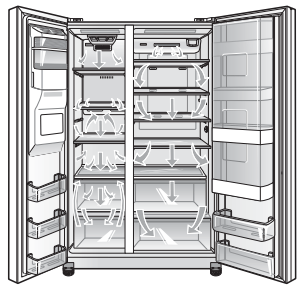
IMPORTANT:
Because air circulates between both sections, any odors formed in one section will transfer to the other. You must thoroughly clean both sections to eliminate odors.
To prevent odor transfer and dried out food, wrap or cover foods tightly. (See the Food Storage Guide section for details.)
Control Panel Features
Depending on the model, some of the following functions may not be available.
Vertical Display
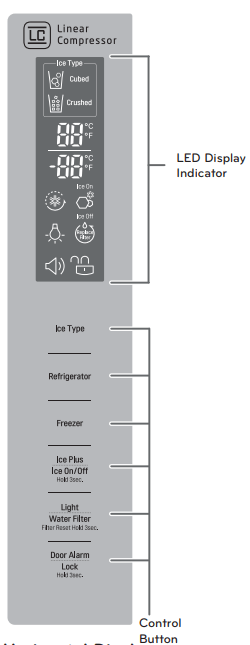
Horizontal Display
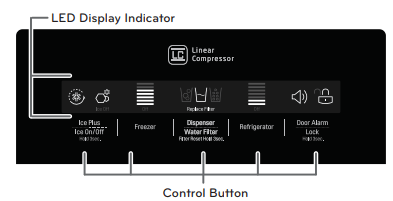
Ice Type
Vertical Display
Select Crushed Ice or Cubed Ice by pressing the Ice Type button repeatedly to choose the selection desired. The Crushed Ice or Cubed Ice icon will light up to indicate your selection.
 Selecting this icon indicates that cubed ice will be dispensed when the dispenser pad is activated.
Selecting this icon indicates that cubed ice will be dispensed when the dispenser pad is activated.
 Selecting this icon indicates that crushed ice will be dispensed when the dispenser pad is activated.
Selecting this icon indicates that crushed ice will be dispensed when the dispenser pad is activated.
Horizontal Display
Select Crushed Ice, Cubed Ice, or Water by pressing the Dispenser button repeatedly to choose the selection desired. The Icon will light up to indicate your selection.

To dispense water or ice, gently push your cup against the dispenser pad (see page 26).
Temperature
The Refrigerator Temp. Control ranges from 33°F to 46°F (1°C to 8°C). Press the
The refrigerator button to cycle through the available temperature settings one increment at a time.
The Freezer the control tool range is from -6°F to 8°F (-21°C to -13°C). Press the
Freezer button to cycle through the available temperature settings one increment at a time.
NOTE: When changing control settings, wait 24 hours before making additional adjustments. The controls are set correctly when milk or juice is as cold as you would like and when ice cream is firm. If the temperature in either compartment is too cold or too warm, change the setting one increment at a time. Wait 24 hours for the change to stabilize before adjusting again.
Temperature Mode Switch Function (°F <->°C)
If you want to convert °F to °C or vice versa, press and hold the Freezer and Refrigerator buttons at the same time for approximately five seconds. (Type 2 is not available)
Ice Plus 
When you press the Ice Plus button, the graphic will illuminate in the display and will continue for 24 hours. The function will automatically shut off after 24 hours.
You can stop this function manually by pressing the button one more time.
This function increases both ice-making and freezing capabilities.
Ice ON/OFF 
To turn off the automatic icemaker, press and hold the Ice ON/OFF button for three seconds until the Ice Off text is illuminated. To turn on the automatic ice maker, press and hold until the Ice On text is illuminated.
Light 
This light has two settings: ON and OFF. Press the Light button to turn the dispenser light on and off. (Not available on all models)
Water Filter Reset 
When the water filter indicator turns on, you need to replace the water filter. After replacing the water filter, press and hold the ReplFilter-ter button for three seconds to turn the indicator light off. You need to replace the water filter approximately every six months.
Door Alarm 
- When power is connected to the refrigerator, the door alarm is initially set to ON. When you press the Door Alarm button, the display will change to OFF and the Door Alarm function will deactivate.
- When either the refrigerator or the freezer door is left open for more than 60 seconds, the alarm tone will sound to let you know that the door is open.
- When you close the door, the door alarm will stop.
Lock 
- When power is initially connected to the refrigerator, the Lock function is off
- If you want to activate the Lock function to lock other buttons, press and hold the Door Alarm button for three seconds or more. The Lock icon will display and the Lock function is now enabled.
- When the Lock function is activated, no other buttons will work. The dispenser pad is also deactivated.
- To disable the Lock function, press and hold the Door Alarm button for approximately three seconds.
Display Off Mode
When the refrigerator is in the Display
Off Mode, the display will remain off until a door is opened or a button is pressed.
Once on, the display will remain on for 20 seconds.
Demo Mode (For Store Use Only)
The Demo Mode disables all cooling in the refrigerator and freezer sections to conserve energy while on display in a retail store. When activated, OFF will display on the control panel.
To deactivate:
With either refrigerator door opened press and hold the Refrigerator Temp. and Ice Plus buttons at the same time for five seconds. The control panel will beep and the temperature settings will display to confirm that Demo Mode is deactivated. Use the same procedure to activate the Demo Mode
automatic Icemaker
Ice is made in the automatic icemaker and sent to the dispenser. The icemaker produces 7 cubes per cycle - approximately 70-120 cubes in 24 hours, depending on freezer compartment temperature, room temperature, number of door openings other operating conditions.
- It takes about 12 to 24 hours for a newly installed refrigerator to begin making ice.
- Wait 72 hours for full ice production to occur.
- Ice-making stops when the ice storage bin is full. When full, the ice bin holds approximately 6 to 8 (12-16 oz) glasses of ice
- To turn off the automatic icemaker, set the Ice ON/OFF button on the display to Ice Off .To turn on the automatic icemaker, set the ON/OFF button on the display to Ice On.
- The water pressure must be between 20 and 120 psi (138-827 kPa) on models without a water filter and between 40 and 120 psi on (276-827 kPa) models with a water filter to produce the normal amount and size of ice cubes.
When You Should Turn the Icemaker Off
Set the Ice ON/OFF Button to "Ice Off":
- When the water supply will be shut off for several hours.
- When the ice bin is removed for more than one or two minutes.
- When the refrigerator will not be used for several days.
Normal Sounds You May Hear
- You will hear the sound of cubes drop-ping into the bin and water running in the pipes as the icemaker refills.
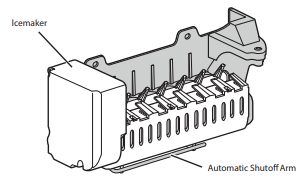
Preparing for Vacation
Set the Ice ON/OFF button to the Ice Off mode and shut off the water supply to the refrigerator.
If the ambient temperature will drop below freezing, have a qualified technician drain the water supply system to prevent serious prop-erty damage due to flooding caused by ruptured water lines or connections.
Power Failure
During a power failure, ice may drop into the freezer compartment. Remove the ice storage bin and discard all the ice. Dry the storage bin and reinstall it. Once power is restored, crushed ice will be selected by default.
Automatic Icemaker (continued)
- The first ice and water dispensed may include particles or odor from the water supply line or the water tank.
- Throw away the first few batches of ice (about 24 cubes). This is also necessary if the refrigerator has not been used for a long time.
- Never store beverage cans or other items in the ice bin for the purpose of rapid cooling.
- Doing so may damage the icemaker or the containers may burst.
- If discolored ice is dispensed, check the water filter and water supply. If the problem continues, contact a qualified service center. Do not use ice or water until the problem is corrected.
- Keep children away from the dispenser.
- Children may play with or damage the controls.
- The ice passage may become blocked with frost if only crushed ice is used. Remove the frost that accumulates by removing the ice bin and clearing the passage with a rubber spatula. Dispensing cubed ice can also help prevent frost buildup.
- Never use thin crystal glass or crockery to collect ice. Such containers may chip or break resulting in glass fragments in the ice.
- Dispense ice into a glass before filling it with water or other beverages. Splashing may occur if ice is dispensed into a glass that already contains liquid.
- Never use a glass that is exceptionally narrow or deep. Ice may jam in the ice passage and refrigerator performance may be affected.
- Keep the glass at a proper distance from the ice outlet. A glass held too close to the outlet may prevent ice from dispensing.
- To avoid personal injury, keep hand your s out of the ice door and passage.
- Never remove the dispenser cover
Ice and Water Dispenser
Depending on the model, some of the following functions may not be available.
Dispenser structure
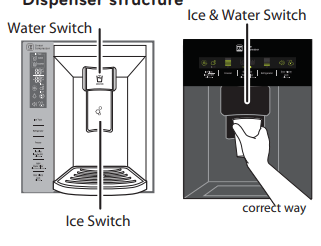
Using the dispenser
- To dispense cold water , push on the water switch with a glass.
- To dispense ice , push on the ice switch with a glass.
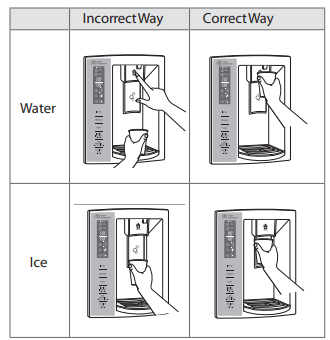
Locking the dispenser
Press and hold the Alarm and Lock buttons simultaneously for 3 seconds to lock the dispenser and all the control panel functions.
Follow the same instructions to unlock.
Cleaning the dispenser stand
The dispenser drip tray has no self-draining function.
It should be cleaned regularly.
Models with a combined ice and water switch do not have a drip tray).
1. To remove, grip the tray with both hands and pull it out. Wipe out dirty areas and dry with a clean cloth.
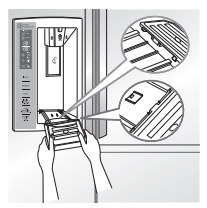
2. To reinstall the tray, slightly tilt the front of the tray and snap the ribs into the holes
Storing Food
Food Preservation Location
Each compartment inside the refrigerator is designed to store different types of food.
Store your food in the optimal space to enjoy the freshest taste.

Food Storage Tips
The following tips may not be applicable depending on the model.
Wrap or store food in the refrigerator in airtight and moisture-proof material unless otherwise noted. This prevents food odor and taste transfer throughout the refrigerator. For dated products, check the date code to ensure freshness.
- Butter or Margarine
- Keep opened butter in a covered dish or closed compartment.
- When storing an extra supply, wrap in freezer packaging and freeze.
- Cheese
- Store in the original wrapping until you are ready to use it. Once opened, rewrap tightly in plastic wrap or aluminum foil.
- Milk
- Wipe milk cartons. For coldest milk, place containers on an interior shelf.
- Eggs
- Store in original carton on interior shelf, not on door shelf.
- Fruit
- Do not wash or hull the fruit until it is ready to be used. Sort and keep fruit in its original container, in a crisper, or store in a completely closed paper bag on a refrigerator shelf.
- Leafy Vegetables
- Remove store wrapping and trim or tear off bruised and discolored areas. Wash in cold water and drain. Place in plastic bag or plastic container and store in vegetable drawer.
- Vegetables with skins (carrots, peppers)
- Place in plastic bags plastic containers and store in vegetable drawers.
- Fish
- Store fresh fish and shellfish in the freezer section if they are not being consumed the same day of purchase. It is recommended to consume fresh fish and shellfish the same day purchased.
- Leftovers
- Cover leftovers with plastic wrap or aluminum foil, or store in plastic containers with tight lids.
- Ice Cream
- When storing frozen food like ice cream for a long period, place it on the freezer shelf, not in the door bins.
Storing Frozen Food
Freezing
Your freezer will not quick-freeze a large quantity of food. Do not put more unfrozen food into the freezer than will freeze within 24 hours (no more than 2 to 3 lbs. of food per cubic foot of freezer space). Leave enough space in the freezer for air to circulate around packages. Be careful to leave enough room at the front so the door can close tightly.
Storage times will vary according to the quality and type of food, the type of packaging or wrap used (how airtight and moisture-proof) and the storage temperature. Ice crystals inside a sealed package are normal. This simply means that moisture in the food and air inside the package have condensed, creating ice crystals.
Packaging
Successful freezing depends on correct packaging. When you close and seal the package, it must not allow air or moisture in or out. If it does, you could have food odor and taste transfer throughout the refrigerator and could also dry out frozen food.
Packaging recommendations packaging recommendations:
- Rigid plastic containers with tight-fitting lids
- Straight-sided canning/freezing jars
- Heavy-duty aluminum foil
- Plastic-coated paper
- Non-permeable plastic wraps
- Specified freezer-grade self-sealing plastic bags
Follow package or container instructions for proper freezing methods.
Do not use
- Bread wrappers
- Non-polyethylene plastic containers
- Containers without tight lids
- Wax paper or wax-coated freezer wrap
- Thin, semi-permeable wrap
Detaching and Assembling the Storage Bins
Fresh Zone Drawers
The Fresh Zone drawers provide storage for fruit and vegetables.
To remove the Fresh Zone drawers, pull out the drawer to full extension, lift the front up, and pull straight out.
To install, slightly tilt up the front, insert the drawer into the frame and push it back into place
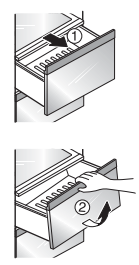

To Remove the Fresh Zone Cover
Hold the cover with both hands and pull it out
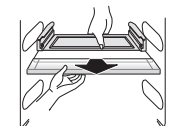
Door Bins
The door bins are removable for easy cleaning and adjustment

1. To remove the bin, simply lift the bin up and pull straight out.

2.To replace the bin, slide it in above the desired support and push down one side at a time until it snaps into place.
Water Tank
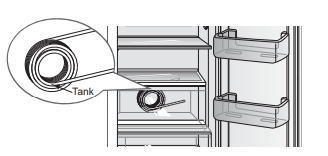
Dairy Corner ( Basic Model )
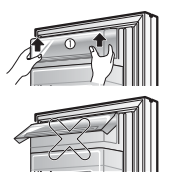
- To remove the Dairy Corner, simply lift the bin up and pull straight out.
- To replace the Dairy Corner, slide it in above the desired support and push down until it snaps into place.
Door-in-Door (Door-in-Door Model)
The Door-in-Door compartment allows for easy access to commonly used food items. The outer Door-in-Door door includes three additional door bins.

Door-in-Door Compartment
To access the Door-in-Door compartment, lightly press the button on the right refrigerator door handle until you hear a click to open the door.
Door-in-Door Case
To open the Door-In-Door case, pull evenly on the marked area.The Door-In-Door Case is removable for easy cleaning and adjustment.
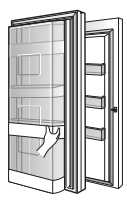
- To remove the Door-In-Door case, lift up and pull out.
- To replace the Door-In-Door case, line the tabs on the Door-In-Door Case with the slots on the door and push down until it snaps into place.
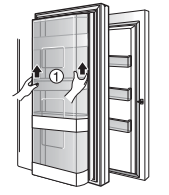
Door-in-Door Door Bins
The Door-in-Door inner and outer door bins are removable for easy cleaning.

- To remove the door bins, lift up and pull out.
- To replace the door bins, slide the door bin in above the desired support and push down until it snaps into place.
Ice storage bin
The ice bin stores the ice cubes made by the icemakers.
If you need to remove the ice storage bin, do so as follows:
Lift the ice storage bin slightly (1) and pull it out (2) as shown in the figure.
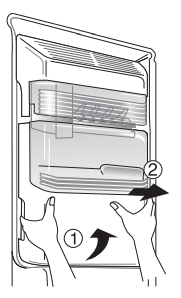
Adjusting the Refrigerator Shelves
The shelves in your refrigerator are adjustable to meet your individual storage needs.
Adjusting the shelves to fit items of different heights will make finding the exact item you want easier. Doing so will also reduce the amount of time the refrigerator door is open which will save energy.
Detaching the Shelf
(1)Remove all items from the shelf. Lift the back of the shelf slightly to disengage the rail stops.
(2) Holding the shelf with both hands, tilt the shelf and pull it out.

Assembling the Shelf
Tilt the front of the shelf up and guide the shelf into the slots at a desired height, keeping shelf holder down. (1)Slide the shelf in, then lower the front of the shelf.(2)
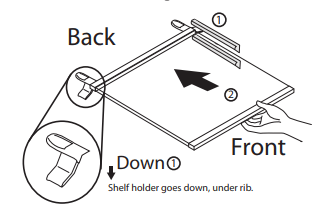
Suggested Placement of Shelves
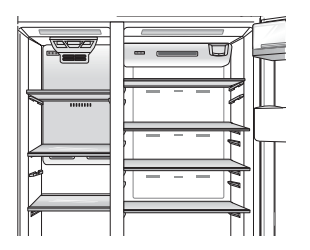
MAINTENANCE
Cleaning
- Both the refrigerator and freezer sections defrost automatically; however, clean both sections about once a month to prevent odors.
- Wipe up spills immediately.
- Always unplug the refrigeration before cleaning.
General Cleaning Tips
- Unplug refrigerator or disconnect power.
- Remove all removable parts, such as shelves, crispers, etc.
- Use a clean sponge or soft cloth and a mild detergent in warm water. Do not use abrasive or harsh cleaners.
- Hand wash, rinse and dry all surfaces thoroughly.
Exterior
Waxing external painted metal surfaces helps provide rust protection. Do not wax plastic parts. Wax painted metal surfaces at least twice a year using appliance wax (auto-paste wax). Apply wax with a clean, soft cloth.
For products with a stainless steel exterior, use a clean sponge or soft cloth and a mild detergent in warm water. Do not use abrasive or harsh cleaners. Dry thoroughly with a soft cloth
Inside Walls (allow freezer to warm up so the cloth will not stick)
To help remove odors, you can wash the inside of the refrigerator with a mixture of baking soda and warm water. Mix 2 tablespoons of baking soda to 1 quart of water (26 g soda to 1 liter water.) Be sure the baking soda is completely dissolved so it does not scratch the surfaces of the refrigerator.
Door Liners and Gaskets
Use a clean sponge or soft cloth and a mild detergent in warm water. Do not use cleaning waxes, concentrated detergents, bleaches, or cleaners containing petroleum on plastic refrigerator parts.
Plastic Parts (covers and panels)
Use a clean sponge or soft cloth and a mild detergent in warm water. Do not use window sprays, abrasive cleansers, or flammable fluids.
These can scratch or damage the material.
Condenser Coils
Use a vacuum cleaner with an attachment to clean the condenser cover and vents. Do not remove the panel covering the condenser coil area.

Replacing the Water Filter
It is recommended that you replace the water filter:
- Approximately every six months.
- When the water filter indicator turns on.
- When the water dispenser output decreases.
- When the ice cubes are smaller than normal
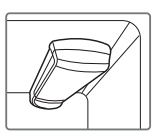
Remove the old water filter. Lower or remove the top left shelf to allow the water filter to rotate all the way down.
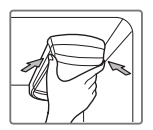
Pinch the sides to open the w over.
Pull the water filter downward and turn it counterclockwise to pull it out. Make sure to rotate the filter down completely before pulling it out of the manifold hole.
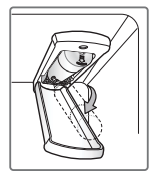
2. Replace with a new water filter.
Take the new water filter out of its packing and remove the protective cover from the orings. With water filter tabs in the horizontal position, push the new water filter into the manifold hole until it stops.
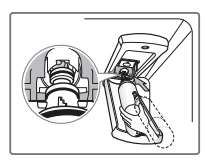
Rotate the water filter up into position and close the cover. The cover will click when closed correctly.
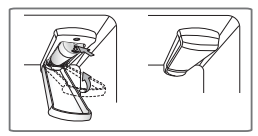
3. After the water filter is replaced, dispense 2.5 gallons of water (flush for approximately five minutes) to remove trapped air and contaminants from the system. Do not dispense the entire 2.5-gallon amount continuously. Depress and release the dispenser pad for cycles of 30 seconds ON and 60 seconds OFF.
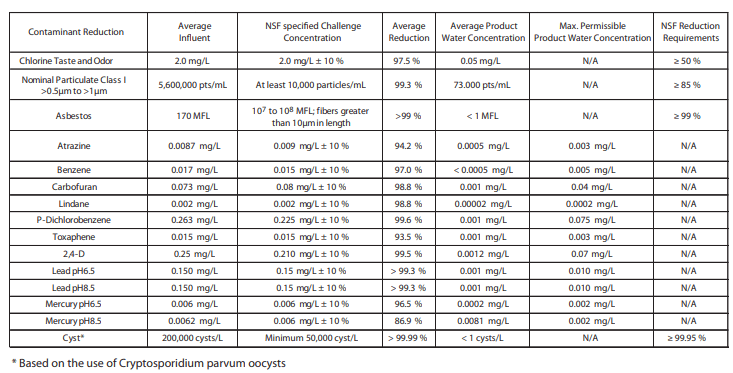

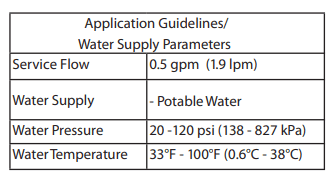
It is essential that the manufacturer’s recommended installation, maintenance and filter replacement requirements be carried out for the product to perform as advertised.
SMART DIAGNOSIS 
Should you experience any problems with your refrigerator, it has the capability of transmitting data via your telephone to the LG service center. This gives you the capability of speaking directly to our trained specialists. The specialist records the data transmitted from your machine and uses it to analyze the issue, providing a fast and effective diagnosis.
If you experience problems with your refrigerator, call to the LG service center. Only use the Smart Diagnosis feature when instructed to do so by the LG call center agent. The transmission sounds that you will hear are normal sounds similar to fax machines.
Smart Diagnosis cannot be activated unless your refrigerator is connected to power. If your refrigerator is unable to turn on, then troubleshooting must be done without using Smart Diagnosis.
USING SMART DIAGNOSISTM
First, call to the LG service center. Only use the Smart Diagnosis feature when instructed to do so by the LG call center agent.
1. Lock the display. To lock the display, press and hold the Lock button for three seconds. (If the display has been locked for over five minutes, you must deactivate the lock and then reactivate it.)
2. Open the refrigerator door
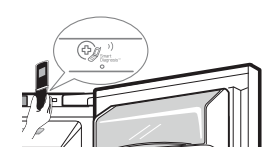
3. Hold the mouthpiece of your phone in front of the speaker that is located on the right hinge of the refrigerator door, when instructed to do so by the call center.
4. Press and hold the Freezer button for three seconds while continuing to hold your phone to the speaker.
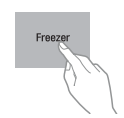
5. After you hear three beeps, release the Freezer button.
6. Keep the phone in place until the tone transmission has finished. This takes about three seconds, and the display will count down the time. Once the countdown is over and the tones have stopped, resume your conversation with the specialist, who will then be able to assist you in using the information transmitted for analysis.
TROUBLESHOOTING
Common Product Questions
How do I unclog the ice dispenser chute?
Eliminate the front of ice fragments by removing the ice bin and clearing the chute with a plastic utensil. Dispensing cubed ice can also help prevent frost or ice fragment buildup.
Make sure that the refrigerator doors are closed before attempting to dispense ice.
Why are ice crystals and frost forming on my frozen food?
When the doors are opened often or for long periods of time, warm, humid air enters the compartment. This raises the temperature and moisture level within the compartment The increased moisture will lead to frost and condensation. To lessen the effect, reduce the frequency and duration of door openings.
How long will it take for my ice bin to fill completely?
Once the ice supply in the bin has been completely exhausted, it may take up to 90 minutes before additional ice is available, and approximately 72 hours to completely refill the bin.
Why does my ice and water taste unusual?
It is recommended that you replace the water filter:
- Approximately every 6 months.
- When thfiltersri filter indicator turns on.
- When the water dispenser output decreases.
- When the ice cubes are smaller than normal.
If your refrigerator was recently installed, dispense 2.5 gallons of water use for approximately 5 minutes) to remove trapped air and contaminants from the system. Do not dispense the en2.5-gallon amount continuously. Depress and release the dispenser pad for cycles of 30 seconds ON and 60 seconds OFF.
Noises You Might Hear noises You Might Hear
Clicking
- The defrost control will click when the automatic defrost cycle begins and ends. The thermostat control (or refrigerator control on some models) will also click when cycling on and off
- Normal Operation
Rattling
- Rattling noises may come from the flow of refrigerant, the water line on the back of the unit, or items stored on top of or around the refrigerator.
- Normal Operation
- Refrigerator is not resting solidly on the floor.
- Floor is weak or uneven or leveling legs need to be adjusted. See the Door Alignment section.
- Refrigerator with linear compressor was jarred while running.
- Normal Operation
Whooshing
- Evaporator fan motor is circulating air through the refrigerator and freezer compartments.
- Normal Operation
- Air is being forced over the condenser by the condenser fan.
- Normal Operation
Gurgling
- Refrigerant flowing through the cooling system.
- Normal Operation
Popping
- Contraction and expansion of the inside walls due to changes in temperature.
- Normal Operation
Sizzling
- Water dripping on the defrost heater during a defrost cycle.
- Normal Operation
Vibrating
- If the side or back of the refrigerator is touching a cabinet or wall, some of the normal vibrations may make an audible sound.
- To eliminate the noise, make sure that the sides and back cannot vibrate against any wall or cabinet.
Dripping
- Water running into the drain pan during the defrost cycle.
- Normal Operation
Pulsating or high-pitched sound
- Your refrigerator is designed to run more efficiently to keep your food items at the desired temperature. The high-efficiency compressor may cause your new refrigerator to run longer than your old one, but it is still more energy-efficient than previous models. While the refrigerator is running, it is normal to hear a pulsating or high-pitched sound.
- Normal Operation
Before Calling for Service
Review this section before calling for service; doing so will save you both time and money.
Cooling
Refrigerator and Freezer section are not cooling
- The refrigerator control is set to OFF (some models).
- Turn the control ON. Refer to the Setting the Controls section for proper temperature settings.
- Refrigerator is set to Demo Mode
- Demo Mode allows the lights and control display to work normally while disabling cooling, to save energy while the refrigerator is on the showroom floor. See the FAQs or the Setting the Controls section of this manual for instructions on how to disable Demo Mode.
- Refrigerator is in the defrost cycle.
- During the defrost cycle, the temperature of each compartment may rise slightly. Wait 30 minutes and confirm the proper temperature has been restored once the defrost cycle has completed.
- Refrigerator was recently installed.
- It may take up to 24 hours for each compartment to reach the desired temperature.
- Refrigerator was recently relocated.
- If the refrigerator was stored for a long period of time or moved on its side, it is necessary for the refrigerator to stand upright for 24 hours before connecting it to power.
The cooling System runs too much.
- Refrigerator is replacing an older model.
- Modern refrigerators require more operating time but use less energy due to more efficient technology.
- Refrigerator was recently plugged in or power restored.
- The refrigerator will take up to 24 hours to cool completely.
- The door is opened often or a large amount of food / hot food was added.
- Adding food and opening the door warms the refrigerator, requiring the compressor to run longer in order to cool the refrigerator back down. In order to conserve energy, try to get everything you need out of the refrigerator at once, keep food organized so it is easy to find, and close the door as soon as the food is removed. (Refer to the Food Storage Guide.)
- Doors are not closed completely.
- Firmly push the doors shut. If they will not shut all the way, see the Doors will not close completely or pop open section in Troubleshooting.
- Refrigerator is installed in a hot location.
- The compressor will run longer under warm conditions. At normal room temperatures (70°F) expect your compressor to run about 40% to 80% of the time. Under warmer conditions, expect it to run even more often. The refrigerator should not be operated above 110°FCondenser/back
- Condenser / back cover is clogged.
- Use a vacuum cleaner with an attachment to clean the condenser cover and vents. Do not remove the panel covering the condenser coil area.
Refrigerator or Freezer section is too warm.
- Refrigerator was recently installed.
- It may take up to 24 hours for each compartment to reach the desired temperature.
- The air vents are blocked.Cold air circulates from the freezer section fresh food section and back again through air vents in the wall dividing the two sections.
- Locate air vents by using your hand to sense airflow and move all packages that block vents and restrict airflow. Rearrange items to allow air to flow throughout the compartment. (Refer to the Airflow diagram in the Using Your Refrigerator section.)
- Doors are opened often or for long periods of time.
- When the doors are opened often or for long periods of time, warm, humid air enters the compartment. This raises the temperature and moisture level within the compartment. To lessen the effect, reduce the frequency and duration of door openings.
- A large amount of food or hot food was added to either compartment.
- Adding food warms the compartment requiring the cooling system to run. Allowing hot food to cool to room temperature before putting it in the refrigerator will reduce this effect.
- Doors not closed correctly.
- See the Doors will not close correctly or pop open section in Parts & Features Troubleshooting.
- Temperature control is not set correctly.
- If the temperature is too warm, adjust the control one increment at a time and wait for the temperature to stabilize. Refer to the Setting the Controls section for more information.
- Defrost cycle has recently completed.
- During the defrost cycle, the temperature of each compartment may rise slightly and condensation may form on the back wall. Wait 30 minutes and confirm the proper temperature has been restored once the defrost cycle The refrigeratoreted.
Refrigerator or Freezer section is too cold.
- Incorrect temperature control settings.
- If the temperature is too cold, adjust the control one increment at a time and wait for the temperature to stabilize. Refer to the Setting the Controls section for more information.
Items in the Cheese & Butter and Condiment bins are not as cool as other items in the refrigerator.
- The Cheese & Butter and Condiment bins will be slightly warmer than the refrigerator compartment.
- This is normal. Items that you would like to keep cooler should be stored in the refrigerator section.
Interior moisture buildup.
- Doors are opened often or for long periods of time.
- When the doors are oned often or for long periods of time, warm, humid air enters the compartment. This raises the temperature and moisture level within the compartment. To lessen the effect, reduce the frequency and duration of door openings.
- Doors not closed correctly.
- See the Doors will not close correctly section in the Troubleshooting section.
- Weather is humid.
- Humid weather allows additional moisture to enter the compartments when the doors are opened leading to condensation or frost. Maintaining a reasonable level of humidity in the home will help to control the amount of moisture that can enter the compartments.
- Defrost cycle recently completed.
- During the defrost cycle, the temperature of each compartment may raise slightly and condensation may form on the back wall. Wait 30 minutes and confirm that the proper temperature has been restored once the defrost cycle has completed.
- Food is not packaged correctly.
- Food stored uncovered or unwrapped, and damp containers can lead to moisture accumulation within each compartment. Wipe all containers dry and store food in sealed packaging to prevent condensation and frost
Food is freezing in the refrigerator compartment.
- Food with high water content was placed near an air vent.
- Rearrange items with high water content away from air vents.
- Refrigerator temperature control is set incorrectly.
- If the temperature is too cold, adjust the control one increment at a time and wait for the temperature to stabilize. Refer to the Setting the Controls section for more information.
- Refrigerator is installed in a cold location.
- When the refrigerator is operated in temperatures below 41°F (5°C), food can freeze in the refrigerator compartment. The refrigerator should not be operated in temperatures below 55°F (13°C)
Frost or ice crystals form on frozen food (outside of package).
- Door is opened frequently or for long periods of time.
- When the doors are opened often or for long periods of time, warm, humid air enters the compartment. This raises the temperature and moisture level with The increased compartment. The increased moisture will lead to frost and condensation. To lessen the effect, reduce the frequency and duration of door openings.
- Door is not closing properly.
- Refer to the Doors will not close correctly or pop open section in the Troubleshooting section.
Cooling/Ice & Water
Frost or ice crystals on frozen food (inside of sealed package).
- Condensation from food with a high water content has frozen inside of the food package.
- This is normal for food items with a high water content.
- Food has been left in the freezer for a long period of time.
- Do not store food items with high water content in the freezer for a long period of time.
Icemaker is not making enough ice.
- Demand exceeds ice storage capacity.
- The icemaker will produce approximately 70-120 cubes in a 24 hour period.
- House water supply is not connected, valve is not turned on fully, or valve is clogged.
- Connect the refrigerator to a cold water supply with adequate pressure and turn the water shutoff valve fully open. If the problem persists, it may be necessary to contact a plumber.
- Water filter has been exhaust filter Replacing the water filter is recommended:
-
- Approximately every six months.
- When the water filter indicator turns on.
- When the water dispenser output decreases.
- When the ice cubes are smaller than normal.
-
- Low house water supply pressure.
- The water pressure must be between 20 and 120 psi (138 - 827 kPa) on models without a water filter and between 40 and 120 psi (276 – 827 kPa) on models with a water filter. If the problem persists, it may be necessary to with a water filter. contact a plumber.
- Reverse Osmosis filtration system is used.
- Reverse osmosis filtration systems can reduce the water pressure below the minimum amount and result in icemaker issues. (Refer to Water Pressure section.)
- Tubing connecting refrigerator to house supply valve is kinked.
- The tubing can kink when the refrigerator is moved during installation or cleaning resulting in reduced water flow. Straighten or repair the water supply line and arrange it to prevent future kinks.
- Doors are opened often or for long periods of time.
- If the doors of the unit are opened often, ambient air will warm the refrigerator which will prevent the unit from maiLoweringthe set temperature. Lowering the refrigerator temperature can help, as well as not opening the doors as frequently.
- Doors are not closed completely.
- If the doors are not properly closed, ice production will be affected. See the Doors will not close completely or pop open section in Parts & Features Troubleshooting for more information.
- The temperature setting for the freezer is too warm.
- The recommended temperature for the freezer compartment for normal ice production is 0°F. If the freezer temperature is warmer, ice production will be affected.
- Refrigerator was recently installed or icemaker recently connected.
- It may take up to 24 hours for each compartment to reach the desired temperature and for the icemaker to begin making ice.
- Icemaker not turned on
- Locate the icemaker ON/OFF button on the display and confirm that it is set to the Ice On mode.
- The ice-detecting sensor is obstructed.
- Foreign substances or frost on the ice-detecting sensor can interrupt ice production. Make sure that the sensor area is clean at all times for proper operation.
- The refrigerator is not connected to a water supply or the supply shutoff valve is not turned on.
- Connect the refrigerator to the water supply and turn the water shutoff valve fully open.
- Icemaker shutoff (arm or sensor) obstructed.
- If your icemaker is equipped with an ice shutoff arm, make sure that the arm moves freely. If your icemaker is equipped with the electronic ice shutoff sensor, make sure that there is a clear path between the two sensors.
Ice has bad taste or odor.
- Water supply contains minerals such as sulfur.
- A water filter may need to be installed to eliminate taste and odor problems. NOTE: In some cases, a filter may not help. It may not be possible tastes move all minerals/odor/tastes in all water supplies.
- Icemaker was recently installed.
- Ice that has been stored for too long will shrink, become cloudy, and may develop a stale taste. Throw away old ice and make a new supply.
- The food has not been stored properly in either compartment.
- Rewrap the food. Odors may migrate to the ice if food is not wrapped properly.
- The interior of the refrigerator needs to be cleaned.
- See the Care and Cleaning section for more information.
- The ice storage bin needs to be cleaned.
- Empty and wash the bin (discard old cubes). Make sure that the bin is completely dry before reinstalling it
Icemakers is making too much ice.
- Icemaker shutoff (arm/sensor) is obstructed
- Empty the ice bin. If your icemaker is equipped with an ice shutoff arm, make sure that the arm moves freely. If your icemaker is equipped with the electronic ice shut-off sensor, make sure that there is a clear path between the two sensors. Reinstall the ice bin and wait 24 hours to confirm proper operation.
Ice is not dispensing.
- Doors are not closed completely.
- Ice will not dispense if any of the refrigerator doors are left open.
- Infrequent use of the dispenser.
- Infrequent use of the ice dispenser will cause the cubes to stick together over time, which will prevent them from properly dispensing. Check the ice bin for ice cubes clumping/sticking together. If they are, break up the ice cubes to allow for proper operation.
- The delivery chute is clogged with frost or ice fragments.
- Eliminate the frost or ice fragments by removing the ice bin and clearing the chute with a plastic utensil. Dispensing cubed ice can also help prevent frost or ice fragment buildup.
- The dispenser display is locked.
- Press and hold the Lock button for three seconds to unlock the control panel and dispenser.
- Ice bin is empty.
- It may take up to 24 hours for each compartment to reach the desired temperature and for the icemaker to begin making ice. Make sure that the shut-off (arm/sensor) is not obstructed. Once the ice supply in the bin has been completely exhausted, it may take up to 90 minutes before additional ice is available, and approximately 24 hours to completdispensedl the bin.
Water is dispensed slowly
- Water filter has been exhausted.
- Replacing the water filter is recommended:
- Approximately every six months.
- When the water filter indicator turns on.
- When the water dispenser output decreases.
- When the ice cubes are smaller than normal.
- Replacing the water filter is recommended:
- Reverse osmosis filtration system is used.
- Reverse osmosis filtration systems can reduce the water pressure below the minimum amount and result in icemaker issues. If the problem persists, it may be necessary to contact a plumber or install a booster pump to compensate for the low pressure.
- Low house water supply pressure.
- The water pressure must be between 20 and 120 psi (138 - 827 kPfilterodels without a water filter and between 40 and 120 psi (276 – 827 kPa) on models with a water filter. If the problem persists, it may be necessary to contact a plumber or install a booster pump to compensate for the low pressure
Water is not dispensing.
- New installation or water line recently connected.
- Dispense 2.5 gallons of water (flush for approximately 5 minutes) to remove trapped air and contaminants from the system. Do not dispense the entire 2.5-gallon amount continuously. Depress and release the dispenser pad for cycles of 30 seconds ON and 60 seconds OFF.
- The dispenser panel is locked.
- Press and hold the Lock button for three seconds to unlock the control panel and dispenser.
- Refrigerator or freezer doors are not closed properly.
- Water will not dispense if any of the refrigerator filters left open.
- Water filter has been recently removed or replaced.
- After the water filter is replaced, dispense 2.5-gallons of water (flush for approximately 5 minutes) to remove trapped air and contaminants from the system. Do not dispense the entire 2.5-gallon amount continuously. Depress and release the dispenser pad for cycles of 30 seconds ON and 60 seconds OFF.
- Tubing connecting refrigerator to house supply valve is kinked.
- The tubing can kink when the refrigerator is moved during installation or cleaning following reducing water flow. Straighten or repair the water supply line and arrange it to prevent future kinks.
- The house water supply is not connected, the valve is not turned on fully, or the valve is clogged.
- Connect the refrigerator to the water supply and turn the water shutoff valve fully open. If the problem persists, it may be necessary to contact a plumber.
Dispensing warm water.
- Refrigerator was recently installed.
- Allow 24 hours after installation for the water storage tank to cool completely.
- The water dispenser has been used recently and the storage tank was exhausted.
- Depending on your specific model, the water storage capacity will range from approximately 20 to 30 oz.
- Dispenser has not been used for several hours.
- If the dispenser has not been used for several hours, the first glass dispensed may be warm. Discard the first 10 oz.
- Refrigerator is connected to the hot water supply.
- Make sure that the refrigerator is connected to a cold water pipe
Ice & Water/Parts & Features
Water has a bad taste or odor.
- Water supply contains minerals such as sulfur.
- A water filter may need to be installed to eliminate taste and odor problems.
- Water filter has been exhausted.
- Replacing the water filter is recommended:
- Approximately every six months.
- When the water filter indicator turns on.
- When the water dispenser output decreases.
- When the ice cubes are smaller than normal.
- Replacing the water filter is recommended:
- Refrigerator was recently installed.
- Dispense 2.5 gallons of water (flush for approximately 5 minutes) to remove trapped air and contaminants from the system. Do not dispense the entire 2.5-gallon amount continuously. Depress and release the dispenser pad for cycles of 30 seconds ON and 60 seconds OFF
Doors will not close correctly or pop open.
- Food packages are blocking the door open.
- Rearrange food containers to clear the door and door shelves.
- Ice bin, crisper cover, pans, shelves, door bins, or baskets are out of position.
- Push bins all covers in and put crisper cover, pans, shelves, and baskets into their correct positions. See the Using Yocoversur Refrigerator section for more information.
- The doors were removed during product installation and not properly replaced.
- Remove and replace the doors according to the Removing and Replacing Refrigerator Handles and Doors section.
- Refrigerator is not leveled properly.
- See Door Alignment in the Refrigeration Installation section to levdifficultrator.
Doors are difficult to open.
- The gaskets are dirty or sticky.
- Clean the gaskets and the surfaces that they touch. Rub a thin coat of appliance polish or kitchen wax on the gaskets after cleaning.
- Door was recently closed
- When you open the door, warmer air enters the refrigerator. As the warm air cools, it can create a vacuum. If the door is hard to open, wait one minute to allow the air pressure to equalize, then see if it opens more easily.
Refrigerator wobbles or seems unstable.
- Leveling legs are not adjusted properly.
- Refer to the Leveling and Door Alignment section.
- Floor is not level.
- It may be necessary to add shims under the leveling legs or rollers to complete installation.
The lights do not work.
- LED interior lighting failure.
- The lamps are LED interior lighting, and service should be performed by a qualified technician.
Parts & Features
The interior of the refrigerator is covered with dust or soot.
- The refrigerator is located near a fire source, such as a fireplace, chimney, or candle.
- Make sure that the refrigerator is not located near a fire source, such, as cafirepa lacee, chimney or candle.
See other models: LFX25974ST LMXS28626D LTCS20220S LSXS26396S LSXS26386D
